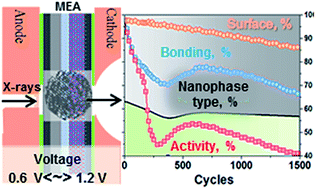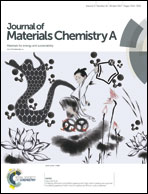Charting the relationship between phase type-surface area-interactions between the constituent atoms and oxygen reduction activity of Pd–Cu nanocatalysts inside fuel cells by in operando high-energy X-ray diffraction†
Abstract
The activity and stability of nanoalloy catalysts for chemical reactions driving devices for clean energy conversion, in particular the oxygen reduction reaction (ORR), depend critically on optimizing major structural characteristics of the nanoalloys, such as the phase composition, surface area and bonding interactions between the constituent atoms, for the harsh operating conditions inside the devices. The effort requires good knowledge of the potential effect of changes in these characteristics on the catalytic functionality of the nanoalloys and, hence, on the devices' performance. We present the results from an in operando high-energy X-ray diffraction (HE-XRD) study on the concurrent changes in the structural characteristics and ORR activity of Pd–Cu nanoalloy catalysts as they function at the cathode of a proton exchange membrane fuel cell (PEMFC). We find that the as-prepared Pd–Cu nanoalloys with a chemical composition close to Pd1Cu1 are better ORR catalysts in comparison with Pd1Cu2, i.e. Pd-poor, and Pd3Cu1, i.e. Pd-rich, nanoalloys. Under operating conditions though, the former suffers a big loss in ORR activity appearing as a slow-mode oscillation in the current output of the PEMFC. Losses in ORR activity suffered by the latter also exhibit sudden drops and rises during the PEMFC operation. Through atomic pair distribution function (PDF) analysis of the in operando HE-XRD data, we identify the structural changes of Pd–Cu alloy NPs that are behind the peculiar decay of their ORR activity. The results uncover the instant link between the ever-adapting structural state of ORR nanocatalysts inside an operating PEMFC and the performance of the PEMFC. Besides, our results indicate that, among others, taking control over the intra-particle diffusion of metallic species in nanoalloy catalysts may improve the performance of PEMFCs significantly and, furthermore, in operando HE-XRD can be an effective tool to guide the effort. Finally, we argue that, though showing less optimal ORR activity in the as-prepared state, monophase Pd–Cu alloy catalysts with a composition ranging between Pd1Cu1 and Pd3Cu1 may deliver optimal performance inside operating PEMFCs.



 Please wait while we load your content...
Please wait while we load your content...